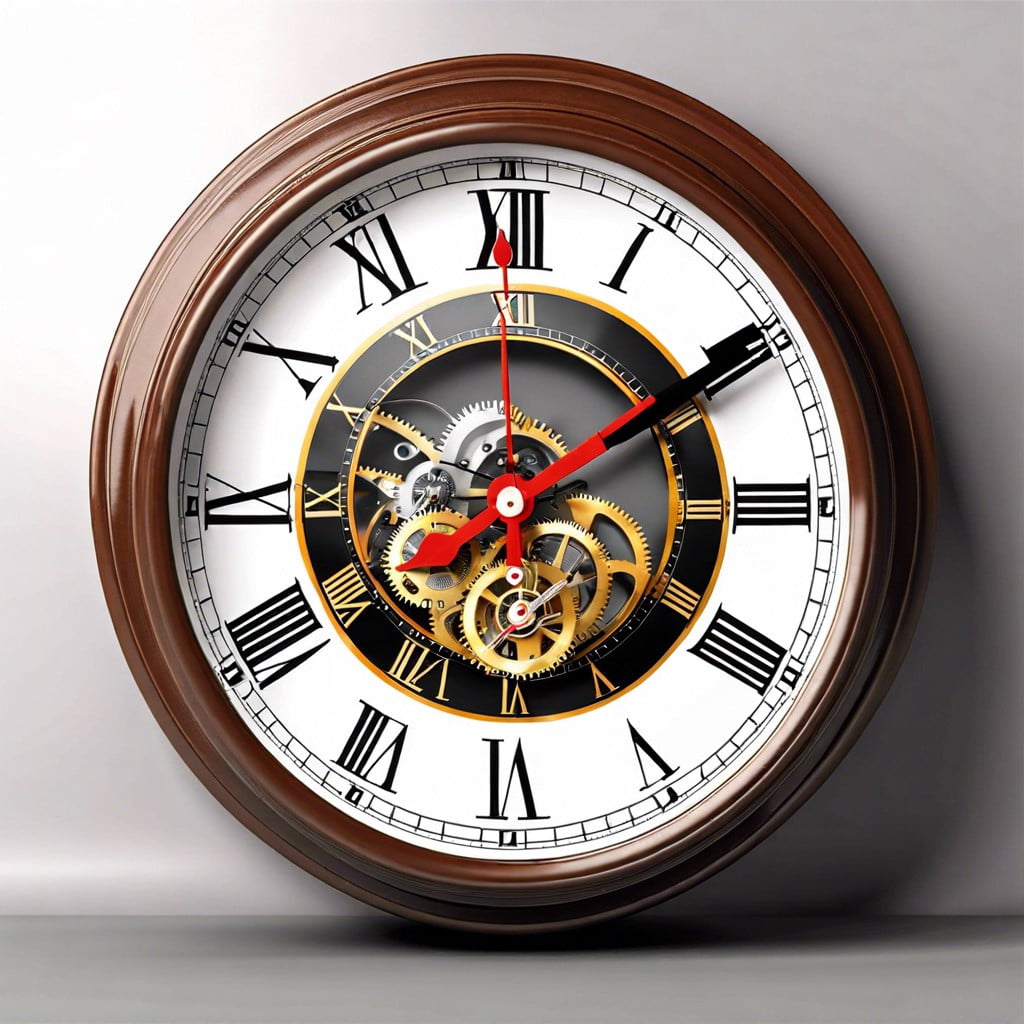Last updated on
Understanding how to calculate time 12 hours from now becomes crucial because it assists in planning ahead effectively and managing your daily tasks efficiently.
Determining the time that lies 12 hours ahead may seem daunting initially, yet with a basic understanding of how to adjust the hour and minute hands, the task becomes straightforward. Whether you’re scheduling a meeting, setting reminders, or simply satisfying your curiosity, this article will guide you through the process effortlessly.
By learning how to tally the minutes and keep up with the hour cycles, you’ll soon realize that adding 12 hours is as simple as transitioning from AM to PM, or vice versa. This article equips you with the necessary tools to calculate future time, ensuring precision and ease in managing your schedule no matter the time of day.
Continue reading for a detailed, step-by-step explanation of how to accurately perform this time calculation.
Key takeaways:
- Start with the current time and note the hour and minute hands’ positions.
- Visualize the hour hand and imagine moving it to the desired number of hours ahead.
- If the current minutes plus additional minutes exceed 60, add an hour for each 60-minute increment.
- Keep track of the number of complete hour cycles.
- Adding 12 hours to any time simply swaps AM for PM.
Understanding Time Addition Basics

When calculating time, envision the face of an analog clock. This timeless tool exemplifies the concept of adding hours:
1. Start with the current time: Note the hour and minute hands’ positions.
2. Visualize the hour hand: Imagine moving it directly to the desired number of hours ahead.
3. Observe minute changes: If the current minutes plus additional minutes exceed 60, add an hour for each 60-minute increment.
4. Maintain your count: Keep track of the number of complete hour cycles (e.g., each 12-hour span).
5. Utilize shortcuts: Adding 12 hours to any time simply swaps AM for PM, or vice versa, if using a 12-hour clock format.
By following these steps, the process of adding hours becomes straightforward.
Determining AM or PM Designation

To accurately determine whether the time will be AM or PM after adding 12 hours to the current time, follow these simple steps:
- Note the current time’s AM or PM designation.
- Realize that adding 12 hours will toggle the time of day from AM to PM or vice versa. For example, if it is 7 AM now, in 12 hours it will be 7 PM.
- Remember that there is no change in the hour numeral when adding exactly 12 hours; only the AM or PM designation changes.
- If the current time is close to 12 o’clock, make sure to correctly move from AM to PM or PM to AM as it crosses the 12 o’clock threshold.
By keeping these points in mind, you can quickly and accurately predict the time 12 hours into the future and whether it falls into the first or second half of the day.
Accounting for Next-Day Transition
When adding 12 hours to the current time, be mindful if the result crosses over to the next day. This occurs if the present time is in the PM. To ensure accuracy:
- If the time is before midday, simply add 12 hours, keeping the date unchanged.
- For PM times, calculate the time by adding the hours remaining to reach midnight to the hours left to cover after midnight.
- Shift the date forward by one day to recognize the transition into a new day.
- Keep the week’s progression in mind; transitioning from Saturday to Sunday brings a new week.
Check for public holidays or daylight saving changes that might affect the calculation, especially if planning for specific events or meetings.
Considering Time Zones
Time zones significantly impact the calculation of what time it will be 12 hours from now. Here are key points to navigate time zone considerations:
- Global Position: Remember, the Earth is divided into 24 time zones. The time in one part of the world can be hours ahead or behind another.
- Coordinated Universal Time (UTC): UTC serves as the primary time standard. Calculate the local time by adding or subtracting the time zone’s offset from UTC.
- Daylight Saving Time: Some regions adjust clocks typically by one hour during certain months. This change could affect the 12-hour calculation.
- Cross-Zone Calculation: Travelers or those communicating across zones should convert to UTC as an intermediary to ensure accuracy before determining the local time plus 12 hours.
- International Date Line: Calculations spanning the International Date Line will result in either a day ahead or a day behind, rather than just a difference in hours.
- Digital Tools Aid: Utilize time zone converters or world clock features on smartphones or computers for quick and precise calculations.
To harmonize communications and avoid confusion, always clarify the time zone when discussing future times with individuals in different locations.
Hours From Now Around The World
When considering what time it will be 12 hours from now, it’s essential to factor in the different time zones around the globe. Here are some key points:
- Each time zone is typically an hour apart, although some can differ by 30 or 45 minutes.
- The Earth is divided into 24 time zones, corresponding to each hour of the day.
- When it is noon in one time zone, it is already 1 PM in the zone to the east and 11 AM in the zone to the west.
- Coordinated Universal Time (UTC) serves as the reference point for determining time zone differences.
- To calculate 12 hours from now in a different time zone, add or subtract the time difference from your current time.
- Keep in mind that some regions adhere to Daylight Saving Time, which can temporarily shift the time by an hour.
It’s always a good practice to use a world clock or an online time zone converter for precise calculations, especially when coordinating with international events or contacts.
Using a 24-Hour Clock for Simplicity
A 24-hour clock, often referred to as military time in the United States, simplifies time calculations by representing the day with hours running from 0 to 23. Here are some points to help understand this system:
1. Conversion Ease: To distinguish AM and PM in a 12-hour cycle, one must keep track of which half of the day they are in. The 24-hour format eliminates this confusion; hours from 00:00 to 11:59 are the same as 12 AM to 11:59 AM, while hours from 12:00 to 23:59 correspond to 12 PM to 11:59 PM.
2. Straightforward Addition: To determine a time 12 hours from now, simply add 12 to the current hour. If the result is 24 or greater, subtract 24 to find the equivalent time on a 12-hour clock.
3. Error Reduction: Since the 24-hour format does not repeat numbers for AM and PM hours, the risk of mistaking the time of day is reduced, leading to fewer scheduling errors.
4. Global Standard: Many regions outside the United States use the 24-hour clock, making it a useful format for international communication and travel scheduling.
5. Practical Application: When using a 24-hour clock, 12 hours from now can be calculated by adding 12. For instance, if it’s currently 15:00 (3 PM), 12 hours later it would be 03:00 (3 AM the following day).
Here’s a quick reference to assist with conversion: 16:00 is 4 PM, add 12 to get 04:00; 8:00 is 8 AM, add 12 to get 20:00. Simple arithmetic without the need to account for an AM/PM switch can make time calculations faster and more intuitive.
Time Calculation Table
A time calculation table simplifies the process of adding hours to the current time without the need for mental arithmetic or devices. It’s particularly useful for visual learners and for those who need a quick reference.
The table is divided into two main columns: one for the current hour and one for the added hours.
For each hour of the day (1 through 12), you’ll see a corresponding hour—this is what time it would be after adding 12 hours.
To use the table, locate the current time on the left column and then move horizontally to find the time 12 hours later.
The table will also indicate whether the time after 12 hours falls on AM or PM.
If the calculation spans two different days, the table might include an additional indication of the day change.
In cases involving different time zones, adjust the current time to the target time zone before using the table.
This quick-reference tool ensures that when you add 12 hours to the current time, accuracy is maintained without needing complex calculations or time conversion tools.
Calculate the Duration Between Two Times
To calculate the duration between two specified times, perform the following steps:
1. Identify the start and end times in hours and minutes. Convert any PM times to a 24-hour format if necessary.
2. If the end time is on the following day, add 24 hours to its time for accurate calculation.
3. Subtract the start time from the end time.
4. Adjust the final duration for any days added in step 2 by converting extra 24-hour segments back into days.
5. If the difference results in a negative number, add 24 hours to represent the correct duration past midnight.
Example: If the start time is 3:45 PM and the end time is 4:15 AM the next day:
1. Convert 3:45 PM to 15:45 (24-hour format).
2. Add 24 hours to 4:15 AM for the next day, resulting in 28:15.
3. Subtract 15:45 (start) from 28:15 (end) to find the duration of 12 hours 30 minutes.
The straightforward process enables easy and precise calculations for time durations.
What Is 12 Hours From Now?
To determine what time it will be 12 hours from the current moment, follow these steps:
- Look at the current time.
- If it’s before noon, simply add 12 to the hour portion of the time. For example, if it’s 8 AM, it will be 8 PM twelve hours later.
- If it’s after noon, calculate the remaining hours until midnight, and add the remaining hours post-midnight. For instance, if it’s currently 3 PM, four hours take you to 7 PM, and the remaining eight hours land you at 7 AM the following day.
- Remember that switching from AM to PM (or vice versa) indicates a shift from ante meridiem (before midday) to post meridiem (after midday).
- Use a clock or watch, a smartphone, or a time-calculating website or application for a more straightforward calculation.
- Take into account the settlement into the next day, especially for schedules and planning, since the 12-hour span crosses two different dates.




